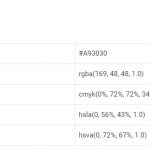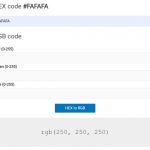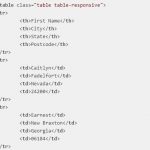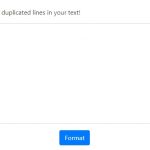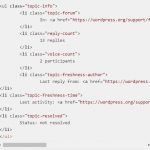Struggling to mock up JSON data for your app or service? Our JSON Data Sample and Examples Generator has got you covered. In a click, get accurate, ready-to-use JSON data that helps you streamline testing and development. Making life easier, one JSON object at a time!
This tool shows examples of messages formatted using JSON, which are generated randomly. To get new set of data, you can refresh this page.
JSON Data Sample
Note: the data below is fictional, they don’t reflect real world data.
JSON example with dynamic data
If you need to modify the example below or create a whole new complicated JSON document, try this json tool.
You can visit TLe Apps for more sample data divided into categories.
Materialize colors JSON Example
{
"red": "#f44336",
"pink": "#e91e63",
"purple": "#9c27b0",
"deeppurple": "#673ab7",
"indigo": "#3f51b5",
"blue": "#2196f3",
"lightblue": "#03a9f4",
"cyan": "#00bcd4",
"teal": "#009688",
"green": "#4caf50",
"lightgreen": "#8bc34a",
"lime": "#cddc39",
"yellow": "#ffeb3b",
"amber": "#ffc107",
"orange": "#ff9800",
"deeporange": "#ff5722",
"brown": "#795548",
"grey": "#9e9e9e",
"black": "#000000",
"white": "#ffffff",
}
Google Maps Markers JSON Example
{
"markers": [
{
"name": "Google, 8th Avenue",
"position": [40.7414728,-74.0055813],
},
{
"name": "Microsoft, Times Square",
"location": [40.7565323,-73.9904037]
},
{
"name": "Tesla, Washington Street",
"location": [40.7411595,-74.0097167]
},
{
"name": "Amazon New York",
"location": [40.7532822,-74.0010696]
}
]
}
JSON rules and tips
Basic rules of a JSON string:
- Data is in name/value pairs.
- Data is separated by commas.
- Curly braces hold objects.
- Square brackets hold arrays.
- It can store nested objects and nested arrays in string format.
- JSON keys need to be surrounded by quotes.
- JSON is case-sensitive because it is basically just a hierarchical structure of objects with keys and values.
- JSON only allows key names to be strings. Numbers can’t be used as keys but you can still them as string like “1”, “2”.
- JSON does not support comments. You can work around it by using a key and value understood as comment.
Best JSON Tools to Parse, Format, Validate
While JSON was originally designed for use by JavaScript programs, these days there are lots of ways to work with JSON including libraries like Python’s json module or PHP’s json_decode function.
Json is also use in web services like yahoo, amazon or twitter among others.
JSONCompare
JSONCompare is for the JSON lovers out there. It helps us to input and validate our codes, while also showing us the difference in two sets of codes or comparing them altogether. With batch uploading you can test your code on all at once, which saves time.
Now with the compare function, JSONs are easily combined into one set of clean coded files–you won’t have to scroll through pages upon pages of complex data anymore!
JsonFormatter
JsonFormatter’s innovative tree view coupled with its many convert and clean functions, makes it an invaluable tool for working with JSON data.
Tree view of formatted JSON to help navigate JSON parameters Proven success in formatting and validating any type of JSON data Interactive converter tools to convert from CSV, XML, or even other types of document formats And many more useful features!
onlineJSONtools
Sometimes, no matter how much you think it’ll be helpful to some people, developers find themselves working with new problems that they’re not sure how to solve. onlineJSONtools is here to save the day with its comprehensive collection of quality JSON utilities that are easy enough for anyone and everybody!
Smarter than some other libraries in the market, these tools work straight out of the box, don’t need any configuration file tweaking, and make every problem solving process easy as pie!
JSON Formatter Chrome extension
JSON Formatter chrome extension is a must have for all web developers. This JSON code highlighterwill allow you to quickly see what your JSON will look like before it’s posted.
It also has other features such as highlighting the syntax, indentation guides and clickable URLs which you can use to edit the original website’s formatting and save time!
CSV JSON
CSV JSON is a more permanent solution for developers who move between the two file types. It’s best feature is the ability to save your progress while you work so you don’t have to start from scratch next time, or share it with co-workers while they take a break from their data entry tasks.
Format conversions aren’t typically something one needs often, so why go through Rigamarole? One visit will be all that it takes when working with CSV JSON, conversion tools for popular data formats that stay up-to-date with changes in standards. Save your session and play around without losing content due to formatting errors like copy/paste mistakes.
Numidian JSON
Numidian JSON is a data processing tool that provides the ability to seamlessly convert between rows of values and tabular values. Numidian JSON also allows for export into databases, CSV files, or duplicate formats.
The web app is simple to use with user-friendly keyboard shortcuts allowing for swift product conversions without any programming knowledge or coding experience needed on your end. There are templates provided in the engine as well as video tutorials on how to perform all required operations without struggling through complicated steps.
JSON FAQs
What is a JSON file used for?
JSON is a popular and efficient data exchange format that can be used to transmit information.
JSON files are typically smaller in size than XML or HTML documents, which makes them an excellent choice for transferring data over limited bandwidth connections, such as mobile networks. Nested objects returned from API can be saved as JSON string for later object mapping.
The simplicity of the content within these files also helps with speedier page load times, making this type of file ideal for use on websites where every second counts!
In addition to being faster and more lightweight than other formats like XML, JSON features shorter development cycles since it doesn’t require parsing before you start work on your project – just open the file directly from your server or local disk! Using less CPU power means that there’s more available resources for doing productive tasks while still loading the file’s content quickly enough.
JSON vs XML
JSON, or JavaScript Object Notation, is a language-independent data storage format that lets you store and organize all of the information in your app. XML stands for eXtensible Markup Language and was originally intended as a universal way to create structured documents containing metadata about any type of object.
Both formats are text files which can be written by hand but usually need special software like JSON Editor Online (free) or Visual Studio Code.
The key difference between these two file types is their structural organization: XML uses tags such as “<title>” and “tags” within the document where JSON doesn’t use them at all! There are many more differences in their document’s structures.
What are differences between JSON and CSV?
CSV files use commas as delimiters between columns in a table that defines what should be stored where; each row is considered an item. They’re not very flexible but can still be useful for storing fairly small amounts of information like contact lists with no sub-elements (like addresses).
JSON uses curly brackets ({}), colons(:) and semi-colons(;) which makes them easier for programmers to work with than CSV files because they don’t need special software programs–programmers just cut and paste from. Element dividers are defined differently.
CSV is easy to create, but JSON offers more flexibility. It’s also popular because it can be easily converted into a JavaScript Object Notation or Java Data Objects.
Why is JSON so popular?
JSON became popular because it is lightweight, easy to read and write with a syntax similar to modern programming language’s array and object. JSON uses text for data storage which means that it can be used in every programming language since all languages have some way of creating strings from the keyboard or variables. The simplicity of this type of file makes storing, updating and reading very efficient and quick with few lines of code required as long as programmers use their resources wisely.
The other main reason why JSON has been embraced by developers is due to its versatility when working with various databases including MySQL, SQLite, Oracle Database and PostgreSQL among others. This also means that there’s less work needed on each individual application level interface (API) side too- just need an API.
How do I create a JSON file?
In order to create the file you will need a text editor like Atom or Notepad from which one can write or edit code using an integrated development environment.
- Open the software up on your computer
- Create a new file with “New File”
- Add content
- Save the file with .json format
